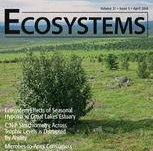Non-native Fish Occurrence and Biomass in 1943 Western Palearctic Lakes and Reservoirs and their Abiotic and Biotic Correlates.
New publication by Carolina Trochine, Sandra Brucet, Christine Argillier, Ignasi Arranz, Meryem Beklioglu, Lluís Benejam, Teresa Ferreira, Trygve Hesthagen, Kerstin Holmgren, Erik Jeppesen, Fiona Kelly, Teet Krause, Martti Rask, Pietro Volta, Ian J. Winfield, Thomas Mehner

Abstract:
Invasion of non-native species is considered a major threat to global biodiversity. Here we present a comprehensive overview of the occurrence, richness and biomass contribution of non-native fish species in 1943 standing water bodies from 14 countries of the Western Palearctic, based on standardised fish catches by multi-mesh gillnetting. We expected strong geographical gradients to emerge in the occurrence of non-natives. We further hypothesised that the contribution by non-natives to the local fish community biomass was correlated with local richness and the trophic level of native and non-native species. Non-native fish species occurred in 304 of 1943 water bodies (16%). If the average number of occupied water bodies per country was weighted by number of water bodies per country, the grand mean occurrence of non-natives in Western Palearctic water bodies was 10%. Exotic (non-native to the Palearctic) and translocated (non-native only to parts of the Palearctic) species were found in 164 (8.4%) or 235 (12.1%) of the water bodies, respectively. The occurrence and local richness of non-native fish species increased with temperature, precipitation and lake area and were substantially higher in reservoirs than in natural lakes. High local biomass contributions of non-native species were strongly correlated with low richness of native species and high richness of non-native species, whereas the trophic level of the fish species had only a weak effect. Single non-native species rarely dominated community biomass, but high biomass contributions and thus strong community and ecosystem impacts can be expected if several non-native species accumulate in a water body.
Ecosystems (2018) 21: 395. doi.org/10.1007/s10021-017-0156-6
